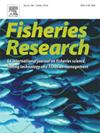Associations between body condition and seasonal freshwater outflow in a coastal marine fish (Protonibea diacanthus) in the wet-dry tropics of northern Australia
IF 2.2
2区 农林科学
Q2 FISHERIES
引用次数: 0
Abstract
Coastal tropical fisheries can be profoundly affected by freshwater flows, with hydrological variability influencing the quality and quantity of nutrition available to marine consumers, and shaping key biological processes such as recruitment, growth and population productivity. In this study, we examined a range of condition metrics (Fulton’s Condition Factor, RNA:DNA, lipid content, gonado-somatic index (GSI), hepato-somatic index (HSI)) from sampled fish to examine the drivers of population productivity and individual health of the commercially important Sciaenid fish, the black-spotted croaker, Protonibea diacanthus, in the wet-dry tropics of northern Australia. The results showed strong seasonal variation in body condition metrics, with a broad trend for lower body condition, HSI and RNA:DNA, and higher tissue water content in the wet season (Dec-Mar) than in the dry (May-Jul) and ‘build-up’ (Sep-Nov) seasons. These results contrast with findings for other key fishery species in the region whose health and condition respond positively to high rainfall and river discharge during strong monsoonal wet seasons. This study cautions the use of broad conclusions about the importance of linkages between freshwater outflows and coastal fishery productivity, without considering spatial and species-specific responses to seasonal variability.
澳大利亚北部干湿热带地区沿海海鱼(原海鱼)身体状况与季节性淡水流出之间的关系
沿海热带渔业可能受到淡水流动的深刻影响,水文变异性影响海洋消费者可获得的营养的质量和数量,并形成关键的生物过程,如征聘、生长和人口生产力。在这项研究中,我们检查了取样鱼类的一系列条件指标(富尔顿条件因子,RNA:DNA,脂质含量,性腺-体细胞指数(GSI),肝-体细胞指数(HSI)),以检查在澳大利亚北部干湿热带地区具有重要商业价值的鱼科鱼类,黑斑croaker, Protonibea diacanthus的种群生产力和个体健康驱动因素。结果显示,体况指标存在强烈的季节变化,体况、HSI和RNA:DNA在雨季(12 - 3月)普遍较低,组织含水量在旱季(5 - 7月)和“积累”季节(9 - 11月)高于旱季(5 - 7月)。这些结果与该地区其他主要渔业物种的调查结果形成对比,这些物种的健康和状况对强季风雨季的高降雨量和河流流量有积极的反应。本研究对使用关于淡水流出量与沿海渔业生产力之间联系的重要性的广泛结论提出警告,而不考虑对季节变化的空间和特定物种的反应。
本文章由计算机程序翻译,如有差异,请以英文原文为准。
求助全文
约1分钟内获得全文
求助全文
来源期刊

Fisheries Research
农林科学-渔业
CiteScore
4.50
自引率
16.70%
发文量
294
审稿时长
15 weeks
期刊介绍:
This journal provides an international forum for the publication of papers in the areas of fisheries science, fishing technology, fisheries management and relevant socio-economics. The scope covers fisheries in salt, brackish and freshwater systems, and all aspects of associated ecology, environmental aspects of fisheries, and economics. Both theoretical and practical papers are acceptable, including laboratory and field experimental studies relevant to fisheries. Papers on the conservation of exploitable living resources are welcome. Review and Viewpoint articles are also published. As the specified areas inevitably impinge on and interrelate with each other, the approach of the journal is multidisciplinary, and authors are encouraged to emphasise the relevance of their own work to that of other disciplines. The journal is intended for fisheries scientists, biological oceanographers, gear technologists, economists, managers, administrators, policy makers and legislators.
 求助内容:
求助内容: 应助结果提醒方式:
应助结果提醒方式:


